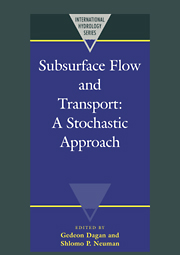Book contents
- Frontmatter
- Contents
- List of contributors
- Preface
- Acknowledgments
- I INTRODUCTION
- II SUBSURFACE CHARACTERIZATION AND PARAMETER ESTIMATION
- III FLOW MODELING AND AQUIFER MANAGEMENT
- IV TRANSPORT IN HETEROGENEOUS AQUIFERS
- 1 Transport of inert solutes by groundwater: recent developments and current issues
- 2 Transport of reactive solutes
- 3 Nonlocal reactive transport with physical and chemical heterogeneity: linear nonequilibrium sorption with random rate coefficients
- 4 Perspectives on field-scale application of stochastic subsurface hydrology
- V FRACTURED ROCKS AND UNSATURATED SOILS
- VI A VIEW TO THE FUTURE
2 - Transport of reactive solutes
Published online by Cambridge University Press: 04 December 2009
- Frontmatter
- Contents
- List of contributors
- Preface
- Acknowledgments
- I INTRODUCTION
- II SUBSURFACE CHARACTERIZATION AND PARAMETER ESTIMATION
- III FLOW MODELING AND AQUIFER MANAGEMENT
- IV TRANSPORT IN HETEROGENEOUS AQUIFERS
- 1 Transport of inert solutes by groundwater: recent developments and current issues
- 2 Transport of reactive solutes
- 3 Nonlocal reactive transport with physical and chemical heterogeneity: linear nonequilibrium sorption with random rate coefficients
- 4 Perspectives on field-scale application of stochastic subsurface hydrology
- V FRACTURED ROCKS AND UNSATURATED SOILS
- VI A VIEW TO THE FUTURE
Summary
INTRODUCTION
Modelling coupled reactions and flow in subsurface formations is of importance in geochemistry for interpreting phenomena such as weathering, diagenesis, ore deposition, etc., in reservoir engineering for predicting displacement of oil by chemical flooding, in contaminant hydrology for predicting the fate of pollutants in soil, groundwater and deep rock formations, and in biogeochemistry for quantifying fluxes along flow paths that control element cycling.
Many theoretical and experimental studies over the past decade have focused on understanding flow and nonreactive transport in heterogeneous aquifers (e.g. Dagan, 1982, 1984, 1989; Gelhar & Axness, 1983; Shapiro & Cvetkovic, 1988; Rubin, 1990; Dagan, Cvetkovic & Shapiro, 1992; Neuman, 1993). The use of geostatistical methods for hydraulic data evaluation, and analytical and/or numerical models for calculating the statistics of Eulerian and Lagrangian fluid velocity, have notably increased our confidence in predictions of nonreactive transport in heterogeneous aquifers. A number of relatively simple analytical models that may account for non-Fickian effects, nonergodic transport conditions, etc., are currently available for macrodispersivity as well as for spatial and temporal moments.
In a parallel development, significant progress in simulations of complex reaction systems has improved our understanding of how, under idealized conditions, reactions influence transport, and how transport influences reactions. Numerical models for many simultaneous reactions are currently available, where reaction rates may vary over several orders of magnitude. Models of varying degree of complexity have been used for generic studies (e.g. Liu & Narasimhan, 1989b; Yeh & Tripathi, 1991; McNab & Narasimhan, 1994; Walter et al, 1994b), as well as for case studies (e.g. Valocchi, Street & Roberts, 1981; Kinzelbach, Schafer & Herzer, 1991).
- Type
- Chapter
- Information
- Subsurface Flow and TransportA Stochastic Approach, pp. 133 - 145Publisher: Cambridge University PressPrint publication year: 1997
- 8
- Cited by



